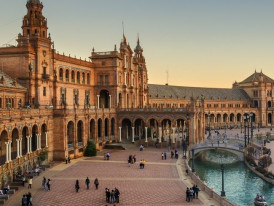
Top 10 attractions in Seville
Discover the charm of this quintessential Andalusian city in the peaceful courtyards and winding alleys of the medieval Barrio Santa Cruz. Take a walk through the beautiful Parque de María Luisa, or bask in the sun as you explore the Plaza de España. Like every great city in Europe, Seville has its share of must-see attractions. While the city’s lively mix of Gothic, Mudéjar, Renaissance, and Modern architecture is dazzling, it’s the lust for life of the Sevillian people that makes a trip to Seville so unique and memorable. These top 10 attractions in Seville will help you kickstart your time in the capital of Spain’s Andalusia region.
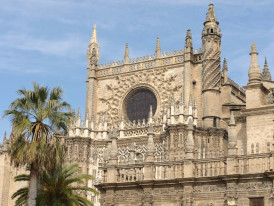
Seville Cathedral
Seville Cathedral
Built on the site of a grand Almohad Mosque, Seville’s medieval cathedral was built to demonstrate Seville’s power and wealth after the Reconquista. At the time of its completion in the 16th century, it supersedes the Hagia Sophia as the largest cathedral in the world. It is still the third-largest church in Europe and the biggest by volume. When you enter the cathedral, you’ll be surprised by the immense proportions of the nave. The five-aisled interior extends 117 meters in length and 76 meters across and soars to 40 meters in height making it not only one of the biggest attractions in Seville but also boasts the most impressive Gothic interior in Spain.

La Giralda
La Giralda
The Giralda is the only remaining structure of the 12th-century mosque torn down during the construction of the Seville Cathedral. Moors built the minaret with a series of ramps so that guards could ride to the top on horseback. Today, the 35 ramps make it easy for visitors to ascend to the summit to enjoy panoramic views of the city below. The bell tower is capped with a bronze weathervane called El Giraldillo, which is a symbol that represents the triumph of faith. The entrance to the tower is located in the cathedral’s northeastern corner. Opening times vary for this attraction, depending on the day so when you’re planning your day full of unmissable things to do in Seville it’s best to check their website before you go.
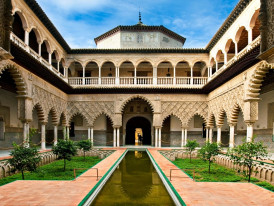
Real Alcázar
Real Alcázar
This UNESCO World Heritage Site, the Real Alcázar was originally the medieval fortress of Moorish rulers and later of the Christian kings. The palace was built in the 10th century for Moorish rulers. In the 11th century, it was governed by the legendary Moorish ruler and poet al-Mu’tamid. You’ll enter the palace through the Puerta Principal, which leads to the Patio de las Doncellas. Be sure to save plenty of time to explore the gardens. These beautifully manicured grounds are filled with leafy palms, sweet orange trees, and colorful roses. In traditional Andalusian style, courtyards, decorative pools, and refreshing fountains are the centerpieces of the landscaping and a must-see while you’re there.

Parque de María Luisa
Parque de María Luisa
Seville’s Parque de María Luisa stretches along the Guadalquivir River near the center of the city. Most of the lush park’s grounds were originally part of the gardens of the Palace of San Telmo and were donated to the city in 1893. Landscape designer Jean-Claude Nicolas Forestier is responsible for the park’s present configuration. Parque de María Luisa is known for its large population of birds, which include doves, swans, parrots, and ducks. Statues, ponds, and fountains scattered throughout the park make it a picturesque and pleasant spot in which to relax in the Spanish sun.
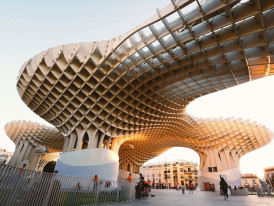
Metropol Parasol
Metropol Parasol
Located at La Encarnacion square in Seville’s Old City district, the newly completed Metropol Parasol is described as the largest wooden structure in the world. Designed by German architect Jurgen Mayer-Hermann, the building features six gigantic umbrella-shaped structures made of birch wood imported from Finland. Nicknamed Las Setas de la Encarnacion, or Incarnacion’s Mushrooms, the modern design has spurred almost as much controversy as the building’s high price tag. This attraction in Seville is home to a marketplace, an Antiquarium, a restaurant, an open-air plaza and offers something to everyone.
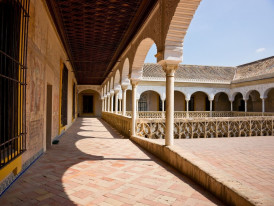
Casa de Pilatos
Casa de Pilatos
Located next to the Plaza de Pilatos, the Caso de Pilatos is considered a premier example of an Andalusian palace. Designed by architect Genoese Antonio Maria Aprile in 1529. Although the building is privately owned by the Medinaceli family, it’s open to the public for guided tours much of the year. Standout features include a series of bullfight paintings by Francisco Goya, a 16th-century marble gate, and a grand staircase ornamented with a Mudéjar-style honeycomb ceiling. If you have time for a private tour of this Andalusian attraction you can find out more about it on their website.
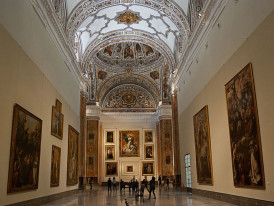
Museum of Fine Arts
Museum of Fine Arts
The buildings in the older parts of the city don’t look Moorish architecture and instead have a highly ornate baroque style. This is because the 17th and 18th centuries were a time of great wealth for Seville, which gave rise to a whole cultural movement. This museum is considered to have the best collection of paintings in Spain after the Prado in Madrid. The collection covers artworks from the Gothic period through to the 20th century. You can expect to see some of the best paintings by famous Spanish artists including El Greco and Pacheco. The museum has a special focus on masterpieces by Murillo, as well as works by the Seville school of the 17th century. There are also religious paintings by Zurbarán that are also excellent.

Torre del Oro
Torre del Oro
Built-in the early 1200s, the watchtower’s name comes from the golden glow that the reflection casts on the river. Today, the tower is home to a maritime museum that outlines the river’s importance throughout Seville’s history. You can enjoy the views of the waterway and city from a rooftop viewing platform. No other structure in Seville better explains the role that the Guadalquivir River played during Spain’s colonial period. Seville owed much of its success in maritime trade to the navigable river, which offered ships more protection than a traditional European port. For centuries, a heavy chain was strung across the river from the tower to protect the city from seafaring invaders.

Barrio Santa Cruz
Barrio Santa Cruz
Located to the east of the Old City, the Barrio Santa Cruz is bordered by the Guadalquivir River. The neighborhood was Seville’s Jewish quarter until the late 1300s when synagogues were closed, homes were confiscated and thousands of Jewish people were either killed or forced to convert to Christianity. Explore the narrow, cobbled alleys and streets, filled with orange trees, colorfully tiled patios, and small-scale plazas as well as a wide array of tapas bars and restaurants. Closed to vehicle traffic, this pedestrian neighborhood is perfect for those who want to experience the ambiance of a medieval Spanish city.

Monasterio de Santa Paula
Monasterio de Santa Paula
This Monasterio de Santa Paula was founded by Doña Ana de Santillan in 1473 for the Jerónimas nuns. For five centuries, this monastery has been devoted to divine worship and the study of Scripture. Within the cloisters of the building, the monastery possesses an important art collection. You can visit the monastery to discover its artistic heritage. If you’re lucky, sometimes the nuns can sell their handmade cakes and confections here too which are the perfect sweet treat in between all of the attractions in Seville.

